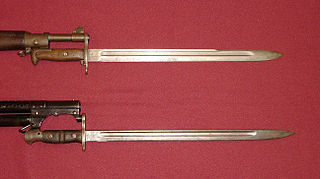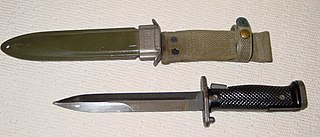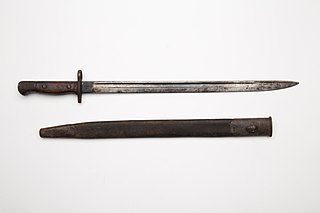Related Research Articles

The M16 rifle is a family of military rifles adapted from the ArmaLite AR-15 rifle for the United States military. The original M16 rifle was a 5.56×45mm automatic rifle with a 20-round magazine.

A bayonet is a knife, dagger, sword, or spike-shaped weapon designed to fit on the end of the muzzle of a rifle, carbine, musket or similar firearm, allowing it to be used as a spear-like weapon. From the early 17th to the early 20th century, it was a melee weapon used by infantry for offensive and/or defensive tactics. Today, it is considered an ancillary weapon or weapon of last resort, although it is still used for ceremonial purposes.
The Colt Canada C7 is a Canadian family of military rifles, manufactured by Colt Canada, having similar design and function to the Colt M16A3.

The 105 mm Howitzer Motor Carriage M7 was an American self-propelled gun vehicle produced during World War II. It was given the official service name 105 mm Self Propelled Gun, Priest by the British Army, due to the pulpit-like machine gun ring, and following on from the Bishop and the contemporary Deacon self-propelled guns.

The vz. 58 is a 7.62×39mm assault rifle designed and manufactured in Czechoslovakia and accepted into service in the late 1950s as the 7,62 mm samopal vzor 58, replacing the vz. 52 self-loading rifle and the 7.62×25mm Tokarev Sa 24 and Sa 26 submachine guns.

A trench knife is a combat knife designed to kill or incapacitate an enemy at close quarters, such as in a trench or other confined area. It was developed as a close combat weapon for soldiers attacking enemy trenches during the First World War. An example of a World War I trench knife is the German Army's Nahkampfmesser.

Personal Load Carrying Equipment (PLCE) is one of several tactical webbing systems of the British Armed Forces. Dependent upon the year of design, and the decade of introduction, the webbing system was named and is commonly referred to as the 85 Pattern, the 90 Pattern or the 95 Pattern webbing.

The OKC-3S is a bayonet developed by the United States Marine Corps to replace the M7 bayonet and M9 bayonet as its service bayonet for the M16 family of rifles and M4 series carbine. This multipurpose bayonet provides greater durability than the M7 bayonet and it also functions as a fighting knife.
The Colt Automatic Rifle or Colt Light Machine Gun is a 5.56 mm NATO, open-bolt, full-automatic-only firearm developed by Colt Defense. It is based on the M16A2/A4, and has a distinctive squared-off handguard, vertical grip, carrying handle and integrated bipod.

The Heckler & Koch HK33 is a 5.56mm assault rifle developed in the 1960s by West German armament manufacturer Heckler & Koch GmbH (H&K), primarily for export.

The M6 Bayonet is a bayonet used by the U.S. military for the M14 rifle, it can also be used with the Mk 14 Enhanced Battle Rifle as well M39 Enhanced Marksman Rifle. It was introduced in 1957, at the same time as the rifle itself. It is the only bayonet made for the M14.

The M7 bayonet is a bayonet that was used by the U.S. military for the M16 rifle, it can also be used with the M4 carbine as well as many other assault rifles, carbines, and combat shotguns. It can be used as a fighting knife and utility tool. It was introduced in 1964, when the M16 rifle entered service during the Vietnam War.

The Model of 1905 bayonet was made for the U.S. M1903 Springfield rifle. This designation was changed to Model 1905 in 1917, and then to M1905 in 1925, when the army adopted the M designation nomenclature. The M1905 bayonet has a 16 in (41 cm) steel blade and a 4 in (10 cm) handle with wooden or plastic grips. The bayonet also fits the U.S. M1 Garand rifle. From 1943 to 1945, a shorter, 10 in (25 cm), bladed version was produced with either black or dark red molded plastic grips, and designated the M1 bayonet. A number of M1905 bayonets were recalled from service, their blades cut down, and reissued as M1 bayonets.
A huge number of M113 Armored Personnel Carrier variants have been created, ranging from infantry carriers to nuclear missile carriers. The M113 armored personnel carrier has become one of the most prolific armored vehicles of the second half of the 20th century, and continues to serve with armies around the world in many roles.

The M5 Bayonet was adopted by the U.S. military in 1953 to replace other bayonets for the M1 Garand rifle. It uses the M8A1 scabbard.

The M3 trench knife or M3 fighting knife was an American military combat knife first issued in March 1943. The M3 was originally designated for issue to soldiers, not otherwise equipped with a bayonet. However, it was particularly designed for use by forces in need of a close combat knife, such as Airborne Units and Army Rangers, so these units received priority for the M3 at the start of production. As more M3 knives became available in 1943 and 1944, the knife was issued to other soldiers such as Army Air Corps crewmen and soldiers not otherwise equipped with a bayonet, including soldiers issued the M1 carbine or a submachine gun such as the M3 submachine gun "grease gun".

The M4 bayonet was introduced in 1944 for use with the M1 carbine. It was built on the M3 fighting knife.

The Pattern 1907 bayonet, officially called the Sword bayonet, pattern 1907 , is an out-of-production British bayonet designed to be used with the Short Magazine Lee Enfield (SMLE) rifle. The Pattern 1907 bayonet was used by the British and Commonwealth forces throughout both the First and Second World Wars.

The C7 Nella Bayonet is a standard issued multi-purpose infantry bayonet by the Canadian Armed Forces of Canada, issued to match the serving standard issued C7/C8 variant rifles, supplied and manufactured by Nella Canada. It was replaced by CAN Bayonet 2000/2005 after 2004.
References
- 1 2 3 4 5 "Bayonets of Post-War Germany". worldbayonets.com. Retrieved 2022-03-21.
- 1 2 3 "Bayonets of Canada". worldbayonets.com. Retrieved 2022-03-21.
- 1 2 "C7/C8 Bayonet Assembly". Nordic Marksman Inc. Retrieved 2022-03-21.